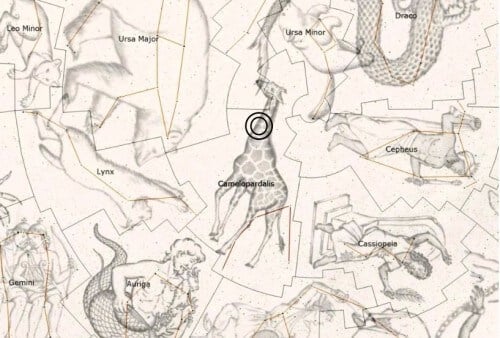According to early models the ideal location would be for North American viewers, but we might get lucky before sunrise in the Old World as well. The comet whose tail particles are responsible for the rain, will also approach the Earth in a week

The news was published before the meter, In the updated news, photos and details about the meter which was sparse but yielded some spectacular meteors.
reminder. As we reported a few weeks ago, tonight (24/5/14), and especially tomorrow, a new meteor shower is expected: The giraffe meter.
North America will be located in the ideal place for viewing the new meteor shower - the Giraffe (Camelopardalids). This is due to the location of the radiant, very close to the North Pole, and the expected peak hours, when in Europe (and Israel) the day will shine.
In any case, the start of the meter is expected at 11:14 PM Greenwich Mean Time (00:XNUMX AM Israel Time) and will end at XNUMX:XNUMX AM (XNUMX:XNUMX PM Israel Time). However, some earlier meteors should not be dismissed, for those who will go to a dark place before sunrise.
Comet 209P/LINEAR is a comet from the Jupiter family that was discovered by the Lincoln Laboratory Near-Earth Asteroid Research (LINEAR) in 2004.
The comet's orbit brings it closer to a distance of about 134 million kilometers from the Sun (that is, within the Earth's orbit or 0.9 astronomical units), and at its far end it is at a distance of five astronomical units (750 million km), that is, near the orbit of Jupiter.
As mentioned, the meteor shower occurs when the Earth meets fragments left by the comet 209P/LINEAR in its path during the last two hundred years, but the comet itself will also come for a visit, when it will approach a distance of about 5.5 million kilometers, a short distance from the cosmic point of view, on May 29, this Admittedly close, but far away from Sapir to rule out the risk of collision. Nor will it be visible to the naked eye except through telescopes and binoculars. This is due to the fact that today it is not an active comet and therefore no one knows how much gas and dust it left in its path. If the comet was also not active in the 18th and 19th centuries, then the meteor shower would be weak, but if it was active, the shower would be strong, with many models predicting that during the peak hours it would be possible to observe a rate of about 200 meteors per hour.
For a special explanation page about the meter on the NASA website

3 תגובות
For a meteorite fan
Shouldn't you have called yourself: "meteor enthusiast"?
Metaroim fan
You noticed that it says at the beginning of the article "The ideal location would be for viewers in North America, but we might be lucky before sunrise".
The fact that you read nonsense does not mean that it is written nonsense 🙂
It's a shame that you write nonsense and send people at five in the morning to high and dark places. We didn't see one star!